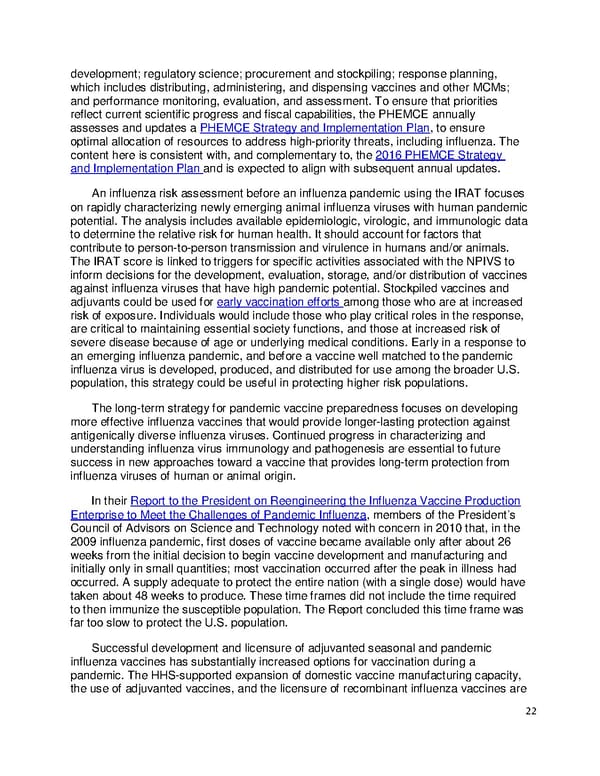development; regulatory science; procurement and stockpiling; response planning, which includes distributing, administering, and dispensing vaccines and other MCMs; and performance monitoring, evaluation, and assessment. To ensure that priorities reflect current scientific progress and fiscal capabilities, the PHEMCE annually assesses and updates a PHEMCE Strategy and Implementation Plan, to ensure optimal allocation of resources to address high-priority threats, including influenza. The content here is consistent with, and complementary to, the 2016 PHEMCE Strategy and Implementation Plan and is expected to align with subsequent annual updates. An influenza risk assessment before an influenza pandemic using the IRAT focuses on rapidly characterizing newly emerging animal influenza viruses with human pandemic potential. The analysis includes available epidemiologic, virologic, and immunologic data to determine the relative risk for human health. It should account for factors that contribute to person-to-person transmission and virulence in humans and/or animals. The IRAT score is linked to triggers for specific activities associated with the NPIVS to inform decisions for the development, evaluation, storage, and/or distribution of vaccines nfluenza viruses that have high pandemic potential. Stockpiled vaccines and against i adjuvants could be used for early vaccination efforts among those who are at increased risk of exposure. Individuals would include those who play critical roles in the response, are critical to maintaining essential society functions, and those at increased risk of severe disease because of age or underlying medical conditions. Early in a response to an emerging influenza pandemic, and before a vaccine well matched to the pandemic influenza virus is developed, produced, and distributed for use among the broader U.S. population, this strategy could be useful in protecting higher risk populations. The long-term strategy for pandemic vaccine preparedness focuses on developing more effective influenza vaccines that would provide longer-lasting protection against antigenically diverse influenza viruses. Continued progress in characterizing and understanding influenza virus immunology and pathogenesis are essential to future success in new approaches toward a vaccine that provides long-term protection from influenza viruses of human or animal origin. In their Report to the President on Reengineering the Influenza Vaccine Production Enterprise to Meet the Challenges of Pandemic Influenza, members of the President’s Council of Advisors on Science and Technology noted with concern in 2010 that, in the 2009 influenza pandemic, first doses of vaccine became available only after about 26 weeks from the initial decision to begin vaccine development and manufacturing and initially only in small quantities; most vaccination occurred after the peak in illness had occurred. A supply adequate to protect the entire nation (with a single dose) would have taken about 48 weeks to produce. These time frames did not include the time required to then immunize the susceptible population. The Report concluded this time frame was far too slow to protect the U.S. population. Successful development and licensure of adjuvanted seasonal and pandemic influenza vaccines has substantially increased options for vaccination during a pandemic. The HHS-supported expansion of domestic vaccine manufacturing capacity, the use of adjuvanted vaccines, and the licensure of recombinant influenza vaccines are 22
 Pandemic Influenza Plan Page 21 Page 23
Pandemic Influenza Plan Page 21 Page 23